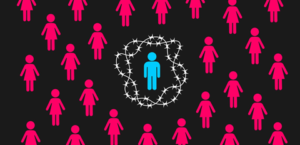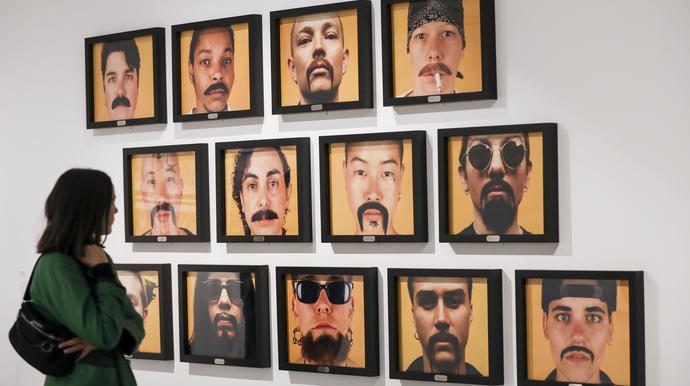by Sophie Houghton
TW – Sexual Abuse, Threats of Violence, Mass Violence

Source: New America
“Misogynist incel men have advocated for the legalization of violent actions to punish and control women, such as rape and beating. Posts have suggested legalized violence against women partners as a justified response to disobedience, not providing sex, or otherwise failing to “fulfil their feminine role.” (Kelly et al, 2021).
What makes a man ‘manly’? Masculinity is a concept that was developed in congruence with feminist theory, and it suggests that there are defining characteristics that make a man. For instance, a common understanding of masculinity is ‘hegemonic masculinity.’ Scholars Connell and Messerschmidt (2005) explain the concept, suggesting that “Hegemonic masculinity was understood as the pattern of practice (i.e., things done, not just a set of role expectations or an identity) that allowed men’s dominance over women to continue.” (832).
Connell and Messerschmidt suggest this as a normative description of masculinity, the pure essence of being a ‘man.’ Conventional characteristics of this notion range from whiteness and heteronormativity, to possessing traits like physical strength, rationality, and a lack of emotion. However, it can be questioned whether this notion stands the test of time, with masculinities beginning to shift. One example case of such change is the notorious Incel movement.
Incels – The Black Pill Ideology
Incel, which stands for involuntary celibate, was conceived by a woman who wanted to create an online community for lonely people, to help them find friends and companionship. This woman requested to remain anonymous, both due to feeling ashamed of the term’s exposure and fearing reprisal for creating a label for alt-right misogynists. An article surrounding this is available in the further readings for this piece. Incels have their own identity theory, using what is termed “pill” vocabulary. This is taken from the film The Matrix, in which the hero Neo must choose between two pills. The blue pill keeps him subdued in an artificial but tolerable world. Instead, Neo chooses the alternative red pill, which makes him truly aware of reality. The third pill, a brainchild of the Incel movement, is the “black pill,” which allows the Incel to become aware of the “immutability of reality.” (Baele et al, 2019:1675) Such Incels see their existence as predetermined, as women choose sexual partners based solely on looks. Therefore, Inceldom becomes a birthright. This differentiates Incels from less extreme misogynists, “who think in terms of the “blue pill/red pill” duality hope that they can take advantage of knowing how society really works to escape their predicament (e.g., invest in aesthetic surgery or gym membership, become “pickup artists” (Baele et al, 2019:1675). Incels, however, believe this life inescapable, and attempt to escape through societal change, advocating for terror and mass violence.

Source: UCSB
An infamous example of such violence is the 2014 Isla Vista killings, where Elliot Rodger, a 22-year-old extremist, killed 6 people and injured 14 others. Rodger’s rampage, accompanied by a 141-page manifesto detailing his beliefs, was motivated by a hatred of women, who had denied him sex. His shooting spree was his ‘Day of Retribution,’ before he killed himself. Rodgers believed himself a victim of his birthright and became a martyr for the Incel movement. The moving image above is a vigil held by the University of California Santa Barbara (UCSB), as the students gathered to mourn the victims.
A neo-masculinity?
Strangely enough, the characteristics of the Incel vary significantly from those suggested by hegemonic masculinity, which calls into question whether it is high time for new research. Masculine traits stereotypically include assertiveness, confidence, and physical strength. However, with the majority of those who deem themselves an ‘incel,’ the opposite appears true. Often these ‘loner’ types lack self-assurance and possess domineering attitudes, and symbolise an even more sinister masculine group. Debbie Ging (2017) suggests that “many of these new toxic assemblages appear to complicate the orthodox alignment of power and dominance with hegemonic masculinity by operationalizing tropes of victimhood, “beta masculinity,” and involuntary celibacy (incels).” (Ging, 2017:639) An example of such victim mentality was proposed on the banned forum r/Incels, which suggests that Incels believe women are attracted to a handsome jawline. Therefore, due to the lottery at birth, the ‘non-Chad’ is destined to become an Incel. This perfectly encapsulates the Black Pill ideology.

Source: The Independent
As a final point, it seems an appropriate time for research surrounding masculinity to advance. Hegemonic masculinity no longer seems an appropriate tool, as the Incel ideology is one that a surprising number of individuals relate to. The stereotypes of the assertive, dominant man are beginning to fade as ideas on ‘doing gender’ change, with performativity being replaced by inferiority and victimhood. Perhaps an update on the topic is required. Or perhaps, the notion of gender should be reduced to a concept much less important, with the focus being on protecting vulnerable groups from dangerous individuals like the Incel.
Resources
News Articles
The Origins of ‘Incel’ – https://www.theguardian.com/world/2018/apr/25/woman-who-invented-incel-movement-interview-toronto-attack
Elliot Rodger – https://www.bbc.co.uk/news/world-us-canada-43892189
Incels and the Men’s Right’s Movement – https://www.independent.co.uk/voices/incels-alek-minassian-mra-mens-rights-terrorism-toronto-van-attack-a8323166.html
Vigil of the UCSB – https://www.niot.org/blog/ucsb-comes-together-after-mass-shooting-isla-vista
Further Reading
Baele, S.J, Brace, L & Coan, T.G (2021) From “Incel” to “Saint”: Analyzing the violent worldview behind the 2018 Toronto attack, Terrorism and Political Violence, 33:8, 1667-1691, DOI: 10.1080/09546553.2019.1638256
Connell, R.W. and Messerschmidt, J.W. (2005) Hegemonic Masculinity: Rethinking the Concept, Gender & Society. 19(6): 829-859.
Ging, D. (2019) ‘Alphas, Betas, and Incels: Theorizing the Masculinities of the Manosphere’, Men and Masculinities, 22(4), pp. 638–657. doi: 10.1177/1097184X17706401.
Kelly, M, DiBranco, A, Decook, J.R. (2021) Misogynist Incels and Male Supremacism: Overview and Recommendations for Addressing the Threat of Male Supremacist Violence, in Political Reform. Retrieved from: https://www.newamerica.org/political-reform/reports/misogynist-incels-and-male-supremacism/ –
